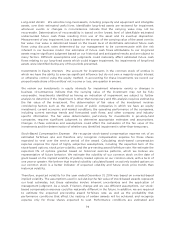Yahoo 2014 Annual Report Download - page 84
Download and view the complete annual report
Please find page 84 of the 2014 Yahoo annual report below. You can navigate through the pages in the report by either clicking on the pages listed below, or by using the keyword search tool below to find specific information within the annual report.
monitored throughout the year. We estimate this forfeiture rate based on historical experience of our
stock-based awards that are granted and cancelled before vesting. If our actual forfeiture rate is
materially different from our original estimates, the stock-based compensation expense could be
significantly different from what we have recorded in the current period. Changes in the estimated
forfeiture rate can have a significant effect on reported stock-based compensation expense, as the
effect of adjusting the forfeiture rate for all current and previously recognized expense for unvested
awards is recognized in the period the forfeiture estimate is changed. If the actual forfeiture rate is
higher than the estimated forfeiture rate, then an adjustment will be made to increase the estimated
forfeiture rate, which will result in a decrease to the expense recognized in our consolidated financial
statements. If the actual forfeiture rate is lower than the estimated forfeiture rate, then an adjustment
will be made to lower the estimated forfeiture rate, which will result in an increase to the expense
recognized in our consolidated financial statements. See Note 14—“Employee Benefits” in the Notes
to our consolidated financial statements for additional information.
Recent Accounting Pronouncements
See Note 1—“The Company and Summary of Significant Accounting Policies” in the Notes to our
consolidated financial statements, which is incorporated herein by reference.
Item 7A. Quantitative and Qualitative Disclosures
About Market Risk
We are exposed to financial market risks, including changes in currency exchange rates and interest
rates and changes in the market values of our investments. We may use derivative financial
instruments to mitigate certain risks in accordance with our investment and foreign exchange
policies.
We enter into master netting arrangements, which are designed to reduce credit risk by permitting
net settlement of transactions with the same counterparty. We present our derivative assets and
liabilities at their gross fair values on the consolidated balance sheets.
Interest Rate Exposure
Our exposure to market risk for changes in interest rates impacts our costs associated with hedging,
and primarily relates to our cash and marketable securities portfolio. We invest excess cash in money
market funds, time deposits, and liquid debt instruments of the U.S. and foreign governments and
their agencies, U.S. municipalities, and high-credit corporate issuers which are classified as
marketable securities and cash equivalents.
In November 2013, we issued $1.4375 billion of the Notes. We carry the Notes at face value less
unamortized discount on our consolidated balance sheets. The fair value of the Notes changes when
the market price of our stock fluctuates.
Investments in fixed rate and floating rate interest earning instruments carry a degree of interest rate
risk. Fixed rate securities may have their fair market value adversely impacted due to a rise in interest
rates, while floating rate securities may produce less income than expected if interest rates fall. Due
in part to these factors, our future investment income may fall short of expectations due to changes
in interest rates or we may suffer losses in principal if forced to sell securities that have declined in
market value due to changes in interest rates. A hypothetical 100 basis point increase in interest rates
would result in a $31 million and $15 million decrease in the fair value of our available-for-sale debt
securities as of December 31, 2014 and 2013, respectively.
80
























